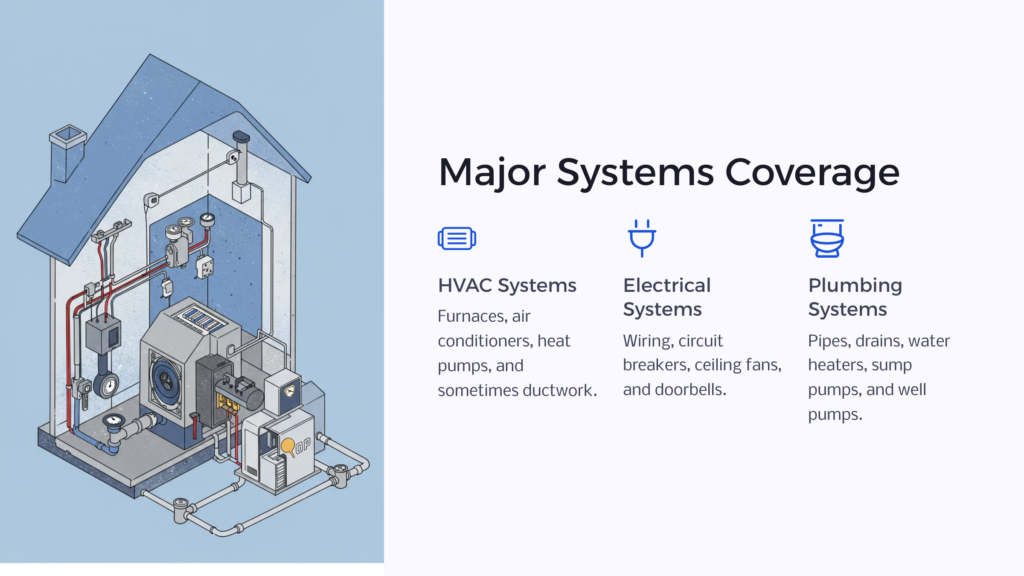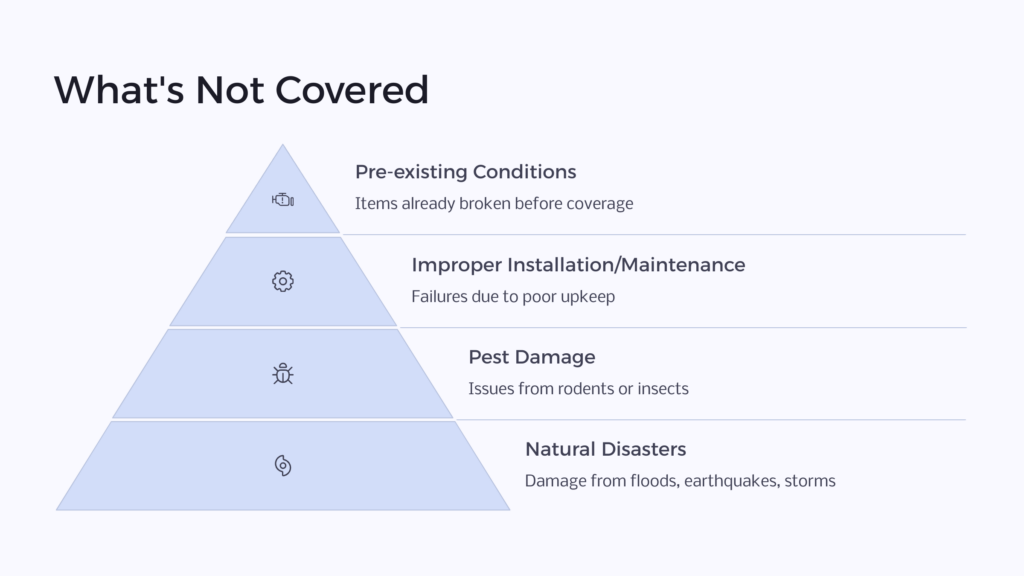A home warranty is a service contract that covers the repair or replacement of major home systems and household appliances when they break down due to normal wear and tear. Unlike homeowner’s insurance, which covers damage from events like fires or storms, a home warranty focuses on the everyday functioning of your home’s essential components.
Home warranties typically last for one year and can be renewed annually. When you have a problem with a covered item, you simply contact your home warranty provider, pay a service fee, and they will send a professional to diagnose and fix the issue.
These contracts are especially popular among first-time homeowners, people selling their homes, and homeowners with older appliances and systems. By choosing the coverage option that best suits your needs, they can be a smart and effective way to budget for home repairs and avoid large, unexpected expenses.
Key Components Covered by Home Warranties

Home warranties generally cover two main categories: home systems and home appliances.
Home systems typically covered include heating, air conditioning, electrical, and plumbing. These are the core systems that keep your home functioning and comfortable. On the appliance side, you’ll often find coverage for home essentials like refrigerators, ovens, dishwashers, and laundry machines.
We should note here that home warranties cover the functional parts of these items. For example, a home warranty might cover the motor in your refrigerator, but not the shelves or drawers inside it. Always read your contract carefully to understand exactly what’s included and what’s not.
Major Systems Typically Included

Most home warranty plans cover the major systems in your home. These are the complex, expensive systems that are essential for daily living and comfort.
- Heating and Air Conditioning (HVAC): Usually covers furnaces, air conditioners, and heat pumps. Some plans may also include ductwork.
- Electrical Systems: Covers your home’s electrical wiring, circuit breakers, and sometimes even smaller things like outlets, ceiling fans, or doorbells.
- Plumbing Systems: Typically includes pipes, drains, water heaters, and sometimes even sump pumps or well pumps.
- Water Heaters: Both tank and tankless water heaters are often covered, including the heating elements and thermostats.
Remember, while these systems are commonly covered, the extent of coverage can vary. For instance, some plans might cover your entire HVAC system, while others might have a different coverage limit for your furnace versus your air conditioner. Always check your specific plan details to understand your coverage.
Common Appliances Under Home Warranty
Home warranties often cover a range of household appliances that you use daily. These are typically standalone units that perform specific functions.
- Refrigerator: Usually includes the main kitchen fridge, but may not cover stand-alone freezers or mini-fridges.
- Oven, Stove, and Range: Both gas and electric models are typically covered.
- Dishwasher: Built-in dishwashers are usually included in standard plans.
- Microwave: Built-in microwaves are often covered, but countertop models may not be.
- Washer and Dryer: Both are commonly included in appliance coverage plans.
- Garbage Disposal: Often covered under basic plans.
- Trash Compactor: If your home has one, it’s often included in more comprehensive plans.
Again, while these appliances are commonly covered, the specific components within each appliance that are covered can vary. For example, a plan might cover the motor in your dishwasher but not the racks or wheels. Review your plan to make sure you understand what is included for each covered appliance.
Optional Add-Ons for Enhanced Coverage
Many home warranty companies offer additional coverage options that you can add to your basic plan for an extra fee. These add-ons allow you to customize your coverage to better fit your home’s specific needs.
- Pool and Spa Equipment: Can cover pumps, heaters, and filtration systems for in-ground pools and spas.
- Septic System: Covers the septic tank and line from the house.
- Well Pump: Covers the pump and related components.
- Roof Leak Repair: Typically covers repairs to leaks over living areas.
- Central Vacuum: Covers the motor and electrical components of built-in vacuums.
- Second Refrigerator or Freezer: Added on to protect multiple refrigerator units.
- Outdoor Kitchen Appliances: Coverage for built-in grills and other outdoor kitchen equipment.
These add-ons can provide valuable protection for homeowners with specific needs. However, they also increase your home warranty cost, so consider carefully which ones are worth the extra expense for your situation.
Exclusions: What Home Warranties Don’t Cover

While home warranties can provide valuable protection, it’s crucial to understand their limitations. Here are some common exclusions you might find in a home warranty contract:
- Pre-Existing Conditions: The item was already broken or improperly maintained before the warranty began.
- Cosmetic Defects: Scratches, dents, or other issues that don’t affect the item’s function.
- Improper Installation or Maintenance: The item or appliance was installed incorrectly or not maintained.
- Code Violations: If repairing an item requires bringing it up to current building codes, the extra cost is often not covered.
- Certain Brands or High-End Models: Some warranties have expense limits on what they’ll pay for repairs or replacements, which may not be enough for luxury brands.
- Animal Damage: Issues caused by rodents, insects, or pets.
- Natural Disasters: Natural disasters are covered by homeowner’s insurance, not home warranties.
Always read your contract carefully to understand what’s excluded. If you’re unsure about anything, don’t hesitate to ask the warranty company for clarification. Understanding these exclusions can help you avoid surprises and make the most of your home warranty coverage.
Cost Factors of Home Warranties
The cost of a home warranty can vary widely based on several factors. Understanding these can help you budget appropriately and choose the right plan for your needs.
- Coverage Level: Basic plans covering just systems or just appliances are generally cheaper than comprehensive plans that cover both.
- Home Size: Larger homes often cost more to cover as they typically have more systems and appliances.
- Location: Prices can vary by state or even zip code.
- Service Fee: Amount you pay for each service call. Plans with higher service fees usually have lower monthly premiums, and vice versa.
- Add-ons: Any optional coverage you add will increase the overall cost.
- Provider: Different companies may charge different rates for similar coverage.
On average, you can expect to pay anywhere from $300 to $600 per year for a basic plan, with more comprehensive coverage costing up to $1,000 or more annually. Remember, while cost is important, it shouldn’t be the only factor in your decision. Consider the coverage limits, exclusions, and company reputation as well.
Comparison: Home Warranty vs. Homeowners Insurance
While both home warranties and homeowner’s insurance provide protection for your home, they cover very different things.
Home Warranty:
- Covers repair or replacement of home systems and appliances due to normal wear and tear
- Is optional (not required by mortgage lenders)
- Typically costs $300-$600 per year, plus service fees
- Covers things like HVAC systems, plumbing, electrical systems, and major appliances
Homeowner’s Insurance:
- Covers damage to your home’s structure and belongings due to perils like fire, theft, or natural disasters
- Is typically required by mortgage lenders
- Cost varies widely based on home value and location, but averages around $1,200 per year
- Covers your home’s structure, personal property, liability, and additional living expenses if you’re temporarily displaced
While homeowner’s insurance protects you from unexpected events, a home warranty helps with the predictable breakdowns that occur over time. Many homeowners find value in having both types of protection. Together, they can provide comprehensive coverage for most home-related issues you might face.
How to Choose the Right Home Warranty Plan
Selecting the right home warranty plan requires careful consideration of your home’s needs and your budget. Here are some steps to help you choose:
- Assess Your Needs: Make a list of the systems and appliances in your home. Consider their age and condition to determine what level of coverage you need.
- Compare Plans: Look into multiple providers. Compare not just prices, but coverage limits, exclusions, and customer reviews.
- Read the Fine Print: Carefully review your contract before signing anything.
- Consider Service Fees: Lower monthly premiums often mean higher service fees, and vice versa. Choose the balance that works best for your budget.
- Check for Customizations: Some companies allow you to adjust your plan to your specific needs.
- Research the Company: Look into the company’s reputation before agreeing to work with them.
- Understand the Claims Process: Make sure you’re comfortable with how claims are handled and how service providers are selected.
Remember, the cheapest plan isn’t always the best value. Look for a plan that offers the coverage you need at a price you can afford, from a company with a good reputation for customer service.
Tips for Getting the Most Out of Your Home Warranty

Once you’ve chosen a home warranty plan, there are several things you can do to maximize its value.
- Understand Your Coverage: Thoroughly read your contract and make sure you understand it.
- Keep Up with Maintenance: Most warranties require that covered items are properly maintained.
- Act Quickly: Submit a claim right away when you notice a problem. Issues can worsen when left unaddressed, and you could void your coverage by allowing the damage to continue.
- Be Present for Repairs: If possible, be home when the technician comes for the repair. You can explain the problem more fully as well as understand the repair process.
- Keep Good Records: Document all interactions with the warranty company and service providers. This will be helpful should you need to follow up on a claim or issue a complaint.
- Use Preferred Providers: Some companies have deals with certain service providers and can give you faster service or discounted prices.
- Consider Renewals Carefully: Reassess your needs every year before you renew your warranties. You may need to change what you have coverage for.
By following these tips, you can ensure you’re getting the most value from your home warranty investment. Remember, a home warranty is a tool to help manage your home repair costs – the more effectively you use it, the more it can save you in the long run.
Frequently Asked Questions About Home Warranties
Q: Are home warranties worth it?
A: This depends on your individual situation. If you have older appliances and systems, or if you prefer predictable home maintenance costs, a home warranty can be valuable. However, if your home is new or you’re handy with repairs, you might not need one.
Q: Can I buy a home warranty at any time?
A: Yes, you can purchase a home warranty at any time, not just when buying a home. However, there’s usually a waiting period (often 30 days) before you can make a claim.
Q: How quickly are claims processed?
A: This varies by company, but most aim to have a technician contact you within 48 hours of filing a claim. Actual repair times can vary depending on the issue and parts availability.
Q: Can I choose my own repair technician?
A: Most home warranty companies have a network of pre-screened technicians they use. Some may allow you to use your own technician, but this often requires pre-approval.
Q: What if a covered item can’t be repaired?
A: If a covered item can’t be repaired, most warranties will replace it. However, this is usually subject to coverage limits specified in your contract.
Q: Do home warranties cover old appliances?
A: Generally, yes. Most home warranties cover old appliances as long as they’re in good working order when the contract begins. However, there may be coverage limits for very old items.
Q: Can I cancel my home warranty?
A: Yes, most companies allow you to cancel at any time. However, there may be cancellation fees, especially if you’ve already used the warranty for a repair.
Remember, while these are common questions, specific answers can vary by provider. Always refer to your specific contract or contact your warranty provider for the most accurate information about your coverage.
Check us out at Homeowner.org for more on home warranties, home improvement, and home remodeling. We’d love to help you optimize your experience as a homeowner!



